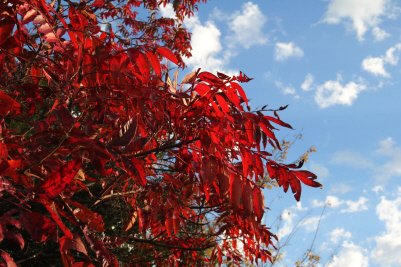





Fall foliage: it is NOT all about trees. Fiery color at eye level, in well chosen shrubbery, brings another element of wow to your autumn landscape.
 As we enjoy the show of trees in autumn we may forget everything else in the landscape. But shrubs can have intensely hued fall leaves. Let's focus on your options with deciduous shrubs that turn red in autumn. The plants discussed here are noted for eye-catching, and reliably red, fall color on deciduous plants.
As we enjoy the show of trees in autumn we may forget everything else in the landscape. But shrubs can have intensely hued fall leaves. Let's focus on your options with deciduous shrubs that turn red in autumn. The plants discussed here are noted for eye-catching, and reliably red, fall color on deciduous plants.
a sumac (Rhus) firing up its gorgeous reds; picture by melody
This species has some of the best scarlet red autumn color out there. Despite the unattractive name, chokeberry is a useful deciduous shrub. Its fall foliage hues are brilliant red to rival the badly behaved winged euonymus. In addition, chokeberry provides a nice set of red fruit. Grow the cheerful chokeberry in most any reasonable garden situation, but do give it sun for the best fruit and foliage show. 'Brilliantissima' is the standard cultivar offering for this Aronia, and is the best choice.
Enkianthus campanulatus, for which the nearest thing to a common name is redvein enkianthus, offers more gorgeous scarlet red fall color. This Asian group is not nearly as common at nurseries as its close cousins, the azaleas. Still, redvein enkianthus is a top choice for autumn foliage. Redvein grows best in the moist, partly shaded, acidic sites that azaleas like. Read more about these in an article by Todd Boland titled "Redvein Enkianthus - Uncommon but Very Worthwhile." Todd names the cultivars 'Red Bell', 'Showy Lantern', 'Princeton Red Bells', 'Sikokianus' and 'Hollandia Red' as all outstanding in their red fall leaves.
Many of the deciduous viburnums show impressive fall color in the red range. Along with fall color, they often have showy, possibly fragrant, flowers and attractive fruit. Most are happy in the standard "well drained, average fertility" soil and will give the their best displays with full sun. Viburnums are usually thought of as flowering shrubs, so notes about their fall color may be sketchy in nursery descriptions. Of the many, many Viburnums, these are cited for their good red fall color:
V. carlesii, Koreanspice viburnum, is a medium sized, somewhat upright bush. The red autumn color is an encore performance after the spring show of incredibly fragrant flowers.
V. nudum, witherod, 'Winterthur' is a shrub of compact habit and medium size. Blazing fall color sets off striking clusters of dark blue fruit.
V. plicatum tomentosum, doublefile Viburnum, is a medium to large shrub carrying its blossoms along interesting horizontal branching. Choose from the cultivars to best suit the space you have for this spreading shrub.
V. trilobum, American cranberrybush, has rich red fall leaf color highlighted with clusters of long lasting, bright red fruit. This is by nature a large shrub, but compact selections are available.
The genus Rhus provides several native American sumacs for your landscape. Their fall foliage colors are generally rich and deep red. Sumacs are tough growers that you can throw in any location. They don't need or especially want the too-often called for "moist well drained organic soil." A reasonably tolerable, unswampy, site will do fine. Their fall colors can vary but most include significant amounts of red or purpleish red. Plant in full sun for the most intense autumn color. One red flag on sumacs: they sucker, a lot. Use them wisely to avoid constant maintenance.
Rhus aromatica 'Gro-Low' is short in stature but long in color. Small flowers give way to red fruit, which is in turn complemented by rich, red to reddish orange, fall leaf color. Gro-Low stays at a resonable one to two foot height. It can be used as a tall ground cover or filler, as it will sucker into a six to eight foot diameter bush. hardy zone 3
Rhus copallina is also known by the names flame leaf sumac, winged sumac, and shining sumac. When you get through all those names, you've gotten a pretty good picture of this plant. Its compound leaves are very shiny, borne on "stems' with noticeable edges (the wings). In fall, the leaves light up with fiery hues. Species winged sumac can grow to large shrub or small tree size, while the selection 'Prarie Flame' is a more compact medium size shrub.
Widely used, inarguably red is the Winged Euonymus (Euonymus alata) This is a tough, popular shrub planted ad nauseum in North American commercial landscapes. If you have only noticed one red shrub, it's probably of this kind. Why the hate for such a striking bush? Because this shrub is so invasive that many nurseries can no longer sell it. Read more about Winged Euonymus in this article by Carrie Lamont, "Don't Get Burned By Burning Bush!"
Dave's Garden PlantFiles
UConn Plant Database (University of Connecticut)
Sincere thanks to admin Melody Rose for the thumbnail photo of Sumac.
Copyright © www.100flowers.win Botanic Garden All Rights Reserved